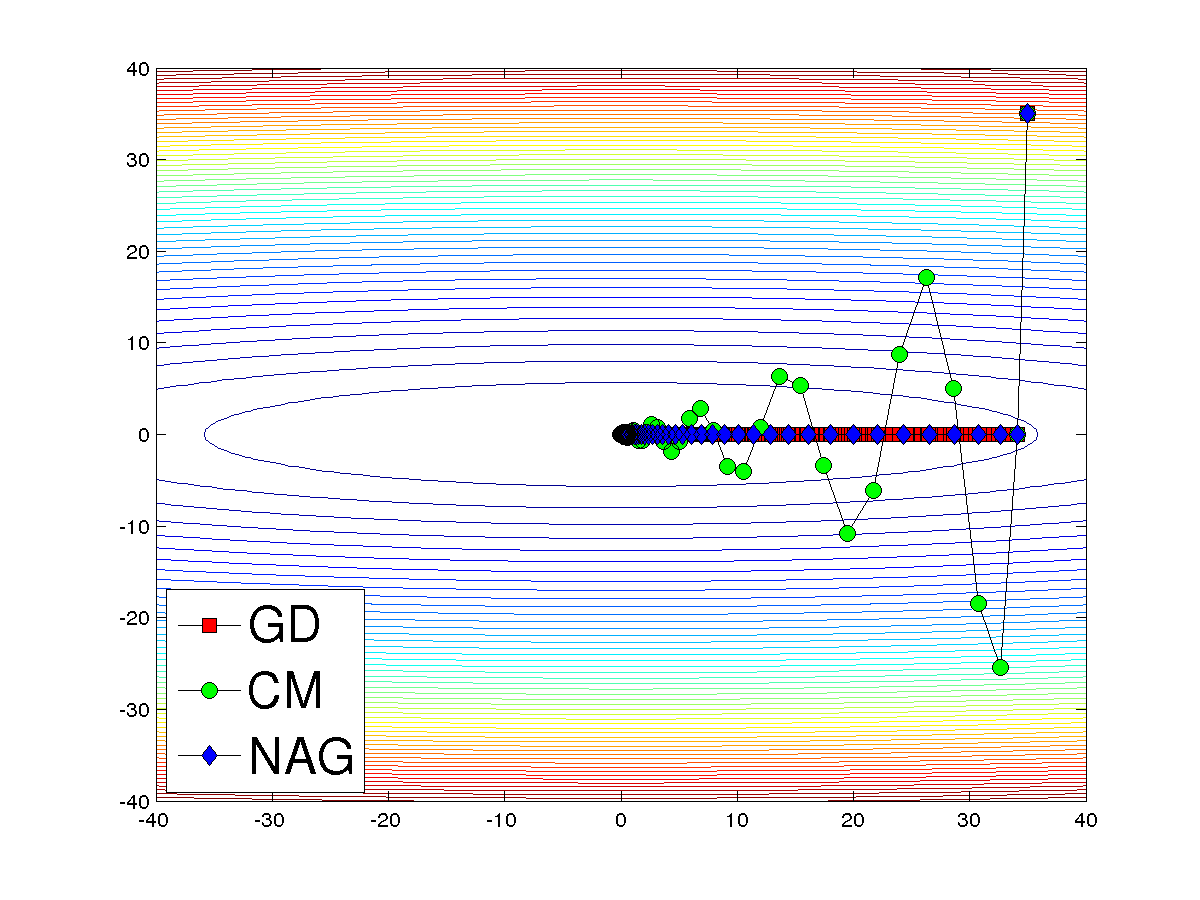Classical Momentum and Nesterov’s Accelerated Gradient Descent
31 Jul 2015冲量(Classical Momentum, 简写为 CM )和 Nesterov 加速 ( Nesterov’s Accelerated Gradient (NAG) ) 在 SGD 中常用,他们的步骤相似。经典的冲量表示如下:
\[\begin{align} \Delta \theta_t &= \alpha \Delta \theta_{t-1} - \eta \nabla f(\theta_{t-1}) \\ \theta_t &= \theta_{t-1} + \Delta \theta_t \end{align}\]Nesterov’s Accelerated Gradient (NAG) 的方法表示如下 [1]
\[\begin{align} y_{s+1} &= x_s - \eta \nabla f(x_s) \\ x_{s+1} &= (1+\alpha)y_{s+1} - \alpha y_s \end{align}\]其中 \(\eta\) 是步长,在 NAG 中 \(\eta = 1/\beta\), \(\alpha = \frac{\sqrt{Q}-1}{\sqrt{Q}+1}\), \(Q\) 是函数的条件数。NAG 的理解比较困难,Sébastien Bubeck 提供了一个从几何角度的解释 [2]。其实 NAG 可以表示为经典的冲量类似的形式 [3]。
我们定义 \(\theta_s = y_s\), 以及 \(\Delta \theta_{s+1} = \theta_{s+1} - \theta_s\), 从 NAG 的 \(x_s\) 的 updating rule 可以得到
\[\begin{align} x_{s+1} &= (1+\alpha) \theta_{s+1} - \alpha \theta_s \\ &= \theta_{s+1} + \alpha (\theta_{s+1} - \theta_s) \\ &= \theta_{s+1} + \alpha \Delta \theta_{s+1} \end{align}\]因此有 \(x_{s} = \theta_{s} + \alpha \Delta \theta_{s}\), 代入 NAG 的 \(y_{s+1}\) 迭代公式可以得到
\[\begin{align} \theta_{s+1} &= \theta_{s} + \alpha \Delta \theta_{s} - \eta \Delta f(\theta_{s} + \alpha \Delta \theta_{s}) \\ \Rightarrow \ \Delta \theta_{s+1} &= \alpha \Delta \theta_{s} - \eta \Delta f(\theta_{s} + \alpha \Delta \theta_{s}) \end{align}\]因此 NAG 可以看作如下的更新过程
\[\begin{align} \Delta \theta_{s+1} &= \alpha \Delta \theta_{s} - \eta \Delta f(\theta_{s} + \alpha \Delta \theta_{s}) \\ \theta_{s+1} &= \theta_s + \Delta \theta_{s+1} \end{align}\]和 CM 对比可以看出, 他们的区别仅仅在于求梯度的步骤, NAG 的梯度要比 CM 要提前一步。如果步长合适, NAG 比 CM 有优势,如果不合适就情况就不一定了。下图中用的步长是对于 NAG 在理想情况下的步长。代码见这里。从图中可以看出 NAG 确实比 CM 更稳定一点。其实如果步长选的不合适,有些情况下 CM 可能会比 NAG 稳定, 因为在求梯度的时候 NAG 比 CM 更激进一点。

Reference
- Bubeck, Sébastien. “Theory of convex optimization for machine learning.” arXiv preprint arXiv:1405.4980 (2014).
- Revisiting Nesterov’s Acceleration
- Sutskever, Ilya, et al. “On the importance of initialization and momentum in deep learning.” Proceedings of the 30th international conference on machine learning (ICML-13). 2013.